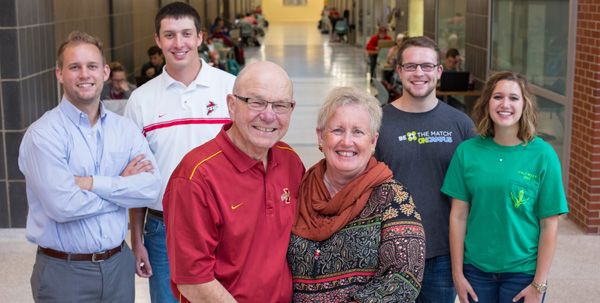
Backing up Baas: Career Building and Student Mentor
Caption: Lecturer Greg Krahn (left), stepped in to lead Baas’ classes and students organized awareness and fundraising events. Tubbs (second from left) and Edan Lambert (right) are bone marrow donors and grad student Billy Marshall (second from right) is a leader in the Be the Match program at Iowa State.
#
In October 2014 Tom Baas received life changing news. He was home sick thinking he had the flu, but went to the emergency room and was diagnosed with pneumonia, anemia and Acute Myeloid Leukemia. He was hospitalized immediately and stayed in the hospital for the next four weeks.
“I was sick—really sick. I went through five chemo treatments over the next several months. Those ended in February 2015. I went back to work in April and fulltime that fall,” says Baas, an animal science professor, student favorite and swine research extension specialist for more than 20 years.
The Block and Bridle Club came to the support of Baas by organizing a Pie the Professor event. Students raised $612 to toss a pie at Greg Krahn, an animal science lecturer who stepped in to lead Baas’ classes when he became ill.
Reciprocal Relationship
Krahn says the way students stepped up to help shows how much they care about Baas.
“If you talk to students in his classes, they would do anything to help him out and I think that shows what kind of person he is and how much people have benefited from his presence at Iowa State,” Krahn says.
“I always told my students they are the best and that’s why companies are knocking at the door to be at our career fairs and meet them,” Baas says.
Baas knows how to make connections for students and understands the pork industry. He worked in the industry for 22 years before starting in his faculty position at Iowa State in 1994.
“My career has been very rewarding,” Baas says. “I brought real-world experiences to the classroom, which helped me prepare students for their careers. I always thought if I helped a student somewhere along the way then I accomplished something.”
One of Baas’ favorite classes was Pork Fellows, a class that introduced students to opportunities and professionals in the pork industry.
“Students had to convince me they wanted a career in the pork industry to get into the course,” Baas says. “Companies were always contacting me and asking if they could meet with students. Students loved it because they could meet with a broad spectrum of professionals.”
Called to Be Bald
Unfortunately, Baas’ Leukemia returned in December 2015, and he started chemotherapy again. This time, the doctor said his only option was a bone marrow stem cell transplant.
“In May of 2016 I had the stem cell transplant,” Baas says. “The transplant was basically a blood transfusion. I don’t remember anything for nine days following the procedure. My wife, Cindy, didn’t tell me until later, but there were three or four days when they weren’t sure if I was going to walk out of there.”
He was initially supposed to be in the hospital for 100 days, but was released after 24. For the next six months his immune system was too low to fight infection, so he could only leave his home to go to weekly doctor appointments in Iowa City.
The same spring Baas was signed up for a stem cell transplant, Chris Mandt, a senior in animal science, started fundraising for Be The Match, a national bone marrow donor registry. He and other members of the Iowa State University Farmhouse Fraternity were planning a Called to Be Bald event to raise awareness about the bone marrow donor program. “We started planning our Called to be Bald before we found out Dr. Baas had Leukemia,” Mandt says. “So, when we found out we decided to raise awareness for him.”
That first year the fraternity held a Called to be Bald event to honor Baas the students raised more than $5,000, but more importantly they raised awareness.
“We are trying to change the stigma around bone marrow donations,” says Billy Marshall, a graduate student in agricultural education and studies who worked with Mandt to organize the
Called to be Bald event. Marshall says people think of bone marrow transplants as painful and expensive. That may have been true years ago, but today bone marrow donations are similar to blood donations.
“There are two different types of donations. If an adult donates to another adult it’s basically pulling stem cells from your blood, so it’s similar to a blood donation,” Marshall says. “For children, doctors prefer to use bone marrow. The process involves a shot in the hip and anesthesia is administered, similar to pulling a wisdom tooth.”
Always a Cyclone
The hardest doctor’s order for Baas came after the transplant. He was advised not to return to work. Baas says he will miss teaching, advising and the daily interaction with students.
“My goal was always to make students aware of opportunities and put them in contact with industry people. The fun part of advising was watching students come in as uncertain freshmen and graduate in four years as polished individuals,” Baas says.
During the last two years Baas says the Iowa State University community of students, staff and friends have shown their support in numerous ways.
“We used a Caring Bridge site to let folks know what was going on during the hospitalization and the response from students and faculty was great,” Baas says. “Students asked me what they could do to help and I told them to donate blood or sign up to be a bone marrow donor.”
Krahn says Baas kept his sense of humor through it all. During his visits to the University of Iowa Hospital Baas told him, “Leukemia can do some evil things, but I promise I’ll always come back a Cyclone.”


